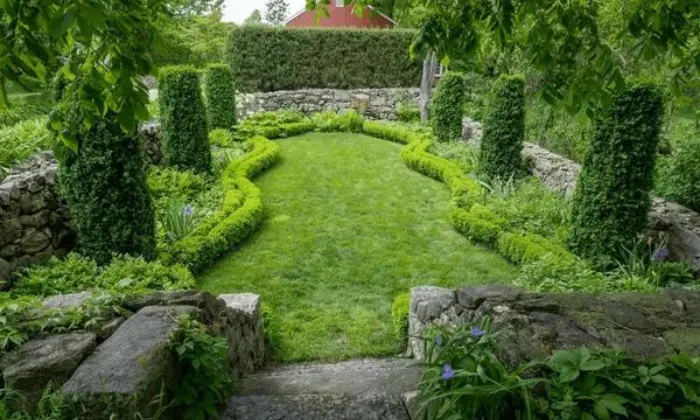Low Maintenance Front Yard Landscaping Tips and Ideas
Low Maintenance front yard landscaping plays a crucial role in enhancing the overall aesthetic appeal…
Boxwood Landscaping: Boxwood (Buxus) is a genus of flowering plants from the family Buxaceae and is a popular choice when it comes to landscaping. It is native to Europe, Asia, and North Africa, and can come in different kinds, such as Common boxwood (Buxus sempervirens), which grows up to six feet in height and has dense leaves that are usually glossy.
This shrub is also called English boxwood due to its large use throughout many English gardens. Other kinds include American Boxwood, English, Common, Korean, Winter Gem, and Green Mountain Boxwood.
To spruce up your outdoor space look no further than boxwood landscaping! By utilizing a variety of shrubs, trees, and plants, boxwood landscaping provides countless options for unique designs and projects.
Boxwoods are ideal for creating formal settings with low-maintenance upkeep that can easily transition from season to season. One of the best Tree and Landscaping Services providers in Whittier, CA are Robert Complete Care.

These are some kinds of boxwood for Landscaping:
Common Boxwood: It grows up to six feet in height and has dense leaves that are usually glossy. This shrub is also called English boxwood due to its large use throughout many Englis
Japanese Boxwood: Japanese Boxwood can grow to a maximum of eight feet and its leaves tend to be thinner.
American Boxwood: American Boxwood typically does not get taller than four feet.
Korean Boxwood: Its leaves slightly have yellowish-green tones.
Winter Gem Boxwood: (for its ability to withstand cold weather; and Green Mountain boxwood, which combines a higher drought tolerance with excellent shape retention over time.
All these options create endless possibilities for landscaping projects made with what truly may be considered the cornerstone of gardening: the Boxwoods family.
Boxwood landscaping is an effective way to spruce up the front of a house. Boxwoods are popular for their attractive green foliage blended with interesting variations of texture and size. Boxwoods can be planted in masses for:
When incorporating Boxwoods into any landscape design, it is important to consider sun exposure, moisture levels, and soil conditions, since Boxwoods can only thrive when they have enough light, shade and water.
Simple boxwood landscaping is a great alternative if you’re searching for a low-maintenance option or a quick method to freshen up your outdoor space.
simple boxwood landscaping is an excellent solution. Ideas range from classic patterns of boxwoods, which can be arranged in myriad shapes to form short or tall hedges, to incorporating boxwood buds that provide texture and interest with the right potted plantings.
Natural flowering shrubs and perennials are also ideal companion plants when creating a beautiful and long-lasting boxwood garden that provides plenty of curb appeal.
Whether you have a small patio or a sprawling backyard, implementing some smart simple boxwood landscaping ideas can turn any outdoor area into an eye-catching sanctuary.
Dwarf boxwood landscaping is a recent introduction to the garden world, but it has quickly become one of the best options for creating an attractive and low-maintenance look.
The dwarf boxwood also makes an excellent towering topiary for entryways or near patios and decks. Its pristine look adds an elegant touch that will make your yard stand out from the rest!
Designs for Boxwood Landscaping: For millennia, people have used boxwood landscaping as a common landscaping method. Boxwoods are evergreen shrubs, which makes them ideal for turning yards and gardens into a picturesque oasis.
Boxwood landscaping designs come in many different varieties and can be tailored to the individual needs of any property owner. Kinds of designs include:
The best design will depend on individual preferences as well as the budget available; costlier designs tend to be more intricate and require more specialized care. Some of the most common boxwood designs are:
For individuals looking for an affordable option for their landscape design, boxwood-only plantings provide a great opportunity to create lush greenery in a very easy-to-maintain way.
It need not be difficult to design an aesthetically beautiful outdoor living area. Incorporating the bright and evergreen foliage of Green Velvet Boxwood can be a simple, low-maintenance solution for transforming your backyard oasis.
Kinds of designs – some common designs feature boxwood borders around other types of foliage such as azaleas and mondo grass, as well as intricate shapes and angles made up entirely of boxwood.
If you are looking for especially impressive yet inexpensive design schemes, opt for topiary shapes, hedges, and animal figures constructed from Green Velvet Boxwood shrubs.
Of course, if your budget allows it there is also always the costly but attractive option of professionally crafted parterres and intricate knot gardens that utilize the vibrant greenery of this versatile plant.
Whichever way you decide to go with your landscaping ideas, Sod installation, rest assured that incorporating Green Velvet Boxwood will make an indelible mark that adds undeniable appeal to your outdoor area.
Look for reviews and ratings from previous customers to ensure that the provider is reputable and reliable. Moreover, really look at their evaluations and administrations to guarantee that they offer the administrations you really want at a sensible expense.
When it comes to ensuring that your boxwood has the best start, one of the most important steps in its life begins before you even get your hands near a shovel.
Finding the right spot to implant it is crucial, as the region’s soil and sunlight conditions can be the difference between success and failure. Your boxwood will do best in well-draining, loose soil, preferably with a pH balance between 6 and 7.
While any time of year is suitable for planting, fall provides better root system development during mild winters and early springs. If summer stress may be an issue for more mature plants, spring planting should also be considered.
The necessary tools include a spade or trowel and some organic fertilizer. After selecting your desired location and opening the ground, guide your sapling into place making sure that the crown starts slightly higher than ground level; this sets it up for proper water drainage over its lifespan.
Boxwood landscaping is not only a beautiful way to increase your home’s curb appeal, but it requires attention and care to stay healthy and low maintenance.
Keep in mind that boxwoods need regular selective pruning as well as watering. To maintain boxwood landscaping, start by determining what plants are needed for the design you have in mind.
Then develop a maintenance plan that includes regular fertilizing, watering, pesticide applications, and pruning timeframes.
In order to keep flowers looking lush and vibrant during the warmer months, watering should be done at least once a week.
Proper maintenance helps ensure that your boxwood trees remain a valuable addition to your home’s exterior.
When considering the landscaping of your outdoor area, boxwood shrubs can be a great option. Let us see some of the pros and cons of this?
Pros
Cons
So, if you do not have the time for this kind of maintenance this might not be ideal for you. All in all, boxwood landscaping is still a wonderful way to spruce up any outdoor space!
It is crucial to take the cost of any landscaping improvements into account before investing in them.. If you are looking for an attractive yet durable addition to your outdoor space, boxwood landscaping is a smart option. Boxwood is a perennial shrub that can last for many years if properly maintained, making it an economical choice.
Prices may vary based on the sort of boxwood you select and the quantity needed for planting, but they typically range from moderate to high.
With the right professionals at the helm, your investment in boxwood landscaping will pay off handsomely in increased curb appeal and lasting beauty.
There are many factors to take into account when using boxwood as part of your landscaping. From choosing the right varieties to assessing location and soil conditions, proper planning and care can ensure that this beautiful shrub will thrive in your garden and enhance its overall design. You are likely to find the ideal fit for adding boxwood landscaping to your outdoor space with the variety of types and sizes offered. Get in touch to get best ideas.
Well-drained, sunny locations are best for boxwood plants, so if you do not already have existing bedding for the shrubs, now's the time to create one.
The growth pace might range from slow to quick depending on the kind you choose.
Compost-rich soil with neutral pH works best, so that is something else to consider when preparing for planting.
Resistant varieties are usually the best option or check with an expert in your area for advice.
Finally, think about how much trimming or intervention you may need to keep your desired shape and size - often more is better!
Low Maintenance front yard landscaping plays a crucial role in enhancing the overall aesthetic appeal…
How to get rid of moss in your lawn can be a persistent problem, often…
Lawn fungus represents a significant challenge for homeowners and landscape professionals, impacting the aesthetic and…
Best time to water lawn and maintaining a lush, green lawn often involves more than…
Ensuring optimal grass growth is crucial for maintaining a lush and healthy lawn. One of…

Robert’s Complete Care has a proven track record of providing creative, high-quality lawn care Whittier services, CA area.
Copyright © 2023. All rights reserved Robert's Complete Care | Powered by Localpro1.